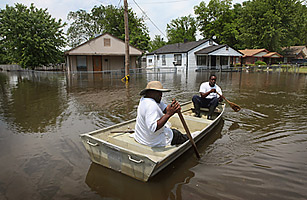
“Welcome to Memphis,” boomed Ben Outlaw, the airport Hertz rental car bus driver, over the speaker system, “home of barbeque, the Civil Rights Museum, riverboats, Graceland and the 100-year flood. You can’t beat that!”
Indeed, regional tourists flocked to Memphis on Monday as the Mississippi River began to crest at 48 ft. — beating the flood of 1927’s 45.9 ft. but still below the river’s all-time high of 48.7 ft. in 1937. Laura Armstrong took her five children, ages 8 to 15, “so that they can see history being made,” she says.
“It’s cool,” says her son Mortavan, 10.
“I wanted to swim in it but they say don’t touch it, and if it gets in your mouth it tastes nasty,” says his 9-year-old sister Lauren.
In the decades since the deadly floods of 1927 and ’37, which claimed hundreds of lives, the Army Corps of Engineers has spent $13 billion shoring up the levees along the Mississippi and creating an intricate system of flood walls and overflow basins. The plan has worked: despite the fact that the population along the Mississippi’s banks has doubled to 4 million people in the past 80 years, the flood of 2011 has yet to claim any lives in Tennessee and has left Memphis relatively intact, making the river’s crest more of a curiosity than an emergency for Memphis’ million residents.
Jam-packed riverboats gingerly navigated the swollen river, trying to avoid the fully grown trees that popped up like corks every now and again. Mud Island, a ritzy peninsula that arcs out from downtown Memphis, was nearly half underwater. Kayakers and canoers paddled where a large park once was. Authorities worried that the river could flood the beautiful, manicured homes on the cape’s northern edge. About 80 miles upstream near Caruthersville, Mo., the river had been closed to barge traffic — currently costing millions of dollars every day in lost commerce — to prevent large wakes from topping levees that are right at the brink of overflowing.
In Memphis, the water went up to the corner of Riverside Drive and Beale Street, home to the city’s still thriving music scene. None of the city’s major landmarks — Sun Studio, Graceland or the National Civil Rights Museum — are threatened, as they sit atop the city’s bluffs. Gawkers rubbernecked along Front Street causing minor fender benders. Irritated groupies of the band Celtic Woman jockeyed for parking with the unexpected crowds, late to the group’s concert at the Orpheum nearby. Fans of the Memphis Grizzlies, the city’s basketball team, arrived early for a game to pose for photos in their jerseys by the river, which stretched nearly 3 miles wide, six times its usual girth. Hundreds of people clogged tourist trolley tracks, forcing annoyed conductors to blast their whistles in vain attempts to hustle parents, children and dogs out of the way. “We run here every Monday, and we’ve never seen anything like it,” says Miles Durfey, 33, a member of the Bar Dog Tavern’s Salty Dogs Running Group. “There were thousands of people along the route … It’s like a carnival.”
Life, though, was less of a carnival for the city’s 400 denizens who spent the night in three evacuation shelters run by the Hope Presbyterian Church. Like a slap in the face, the check-in headquarters were across a mall parking lot from an actual carnival — the Rock ‘n’ Raleigh annual fair. It was a tough call which attraction was drawing more traffic as worried residents streamed through at a steady clip asking if they needed to evacuate, or seeking shelter having been told they must. Some 1,300 homes have been notified to evacuate thus far, mostly in areas where tributaries such as Nonconnah Creek, Wolf River and Loosahatchie River are backing up. “The tributaries have been our biggest worry from the beginning,” says Steve Shular, spokesman at the Memphis/Shelby County Emergency Management Agency. “There are 5,000 properties that in the past have flooded. That’s where the danger is lurking.” President Obama Monday declared a state of emergency for Tennessee to free up federal funds if needed.
Ray and Jayde N. and their five kids, ages 1 to 15, have been living in the gym at the Millington Civic Center, one of the three shelters, since last Tuesday. They don’t know if their home in rural Frayser has flooded, as the roads have been impassable. “We just bought a 40-inch TV,” Jayde says, fingering the kids’ five toothbrushes. “We put it on top of the freezer. I hope it’s O.K.”
After experiencing horrible floods in Waterloo, Iowa, in 2008, Nanny Williams decided to move to Memphis to be close to her daughter and grandchildren. She’d just moved into her new first-floor apartment near the Wolf River on April 1. “Thank God I hadn’t had my furniture delivered yet,” she says. Her daughter, granddaughter and grandson were forced to evacuate their home in nearby Dunlap two weeks ago because of flooding so they had go to Williams’ apartment. The four waited it out until they “saw snakes — like seven of them — and the water was already at the walk.” They were ordered to evacuate on Saturday. “You expect this to happen along the water in Florida, California, Hawaii, even on the banks of the Mississippi,” Williams says, “but you don’t expect it to happen somewhere where it hasn’t for a hundred years.”
So far, says Shular of the emergency-management agency, cases like Williams’ are rare. “We dodged the bullet somehow,” he says. Still, there are risks. Though the river has nearly crested, forecasters are predicting rain for Thursday and Friday — up to half an inch, or over a centimeter. “It shouldn’t make an impact,” Shular says, “but we’ll be right on the edge for the next seven to 10 days. If we get deluged, there’s nowhere for the water to go.”
See TIME’s Pictures of the Week.
See the Cartoons of the Week.